Did you know that cardinals are one of the most sought-after backyard birds in North America? Their stunning red plumage and melodious songs have captivated birdwatchers for generations. If you’re eager to attract these magnificent creatures to your own yard, you’re in luck! In this article, we will explore the best ways to attract cardinals to your yard and provide you with valuable tips for attracting northern and red cardinals. So, get ready to embark on an exciting journey of birdwatching and enhance your backyard with the beauty of cardinals!
The best way to attract cardinals to your backyard is to offer the foods they love like black oil sunflower seeds and safflower seeds, and provide a safe haven with dense shrubs and a water source. Once they find a reliable food source and feel secure, cardinals are more likely to stay and even raise their young in your yard!
Understanding Cardinal Preferences: Habitat and Behavior
Native to certain regions of North America, the Northern Cardinal is a beloved bird species known for its vibrant plumage and beautiful song. Understanding their habitat preferences and behavior can help attract these stunning birds to your backyard.
Native Habitats of Northern Cardinals
Northern Cardinals can be found in areas ranging from Maine to Texas. They prefer habitats with dense foliage and trees, providing them with shelter and nesting sites. Creating a habitat that mimics their native environment is key to attracting cardinals to your yard.
Year-Round Residency and Non-Migratory Patterns
Unlike some bird species, Northern Cardinals are non-migratory birds. Once they find a suitable habitat, they tend to stay year-round. This means that by creating an appealing environment, you can have cardinals as regular visitors to your backyard.
Cardinal Behavior and Backyard Appeal
Cardinals are attracted to backyards that offer a combination of food sources, adequate shelter, and water. Providing a diverse range of seeds, berries, and nuts in bird feeders, along with suitable plants and trees, can make your yard highly appealing to cardinals. They also need access to fresh water for drinking and bathing, so consider adding a birdbath or water feature to your outdoor space.
Feeders Fulfilling Cardinal Diet Needs
Cardinals have a strong, thick beak that is suited for cracking open large seeds and consuming hearty foods. They enjoy safflower seeds, black oil sunflower seeds, crushed peanuts, cracked corn, berries, and suet. Choosing the right feeders and food will help attract cardinals to your yard and keep them well-fed.
Hearty Foods Loved by Cardinals
When it comes to attracting cardinals, offering them a variety of hearty foods is key. These include:
| Food | Description |
|---|---|
| Safflower seeds | Loved by cardinals and disliked by squirrels, safflower seeds are an excellent choice for attracting these beautiful birds. |
| Black oil sunflower seeds | Cardinals are avid consumers of black oil sunflower seeds. These high-energy seeds provide valuable nutrition for them. |
| Crushed peanuts | Cardinals enjoy the rich taste and protein-packed goodness of crushed peanuts. They are a favorite treat for them. |
| Cracked corn | This grain is loved by cardinals and provides them with essential carbohydrates. It can be offered in feeders or scattered on the ground. |
| Berries | Cardinals have a sweet tooth for berries such as mulberries, blackberries, and elderberries. Providing these fruits will surely attract them. |
| Suet | High in fat, suet is a great energy source for cardinals, particularly during the colder months. Offer suet cakes in your feeders. |
Feeder Types That Suit Cardinal Feeding Habits
Now that you know what foods cardinals love, it’s essential to choose the right feeders to accommodate their feeding habits. Consider these options:
Platform feeders: Cardinals prefer feeders with large, flat surfaces where they can easily perch and access their food. Platform feeders with built-in trays or shallow dishes work well.
Hopper feeders: These feeders feature a container with an opening that dispenses food as cardinals eat. They can hold a variety of seed types and attract cardinals with their easy access.
Tube feeders: While not the first choice for cardinals, tube feeders with larger openings can still accommodate their feeding preferences. Opt for feeders with built-in perches to make it easier for cardinals to access the seeds.
Suet feeders: Hanging suet feeders offer cardinals a rich source of energy. Look for feeders that protect the suet from the elements and have suitable perches for cardinals to cling onto while feeding.
Choosing the right feeders and providing a variety of food options will make your yard a desirable feeding spot for cardinals, ensuring they return time and time again.
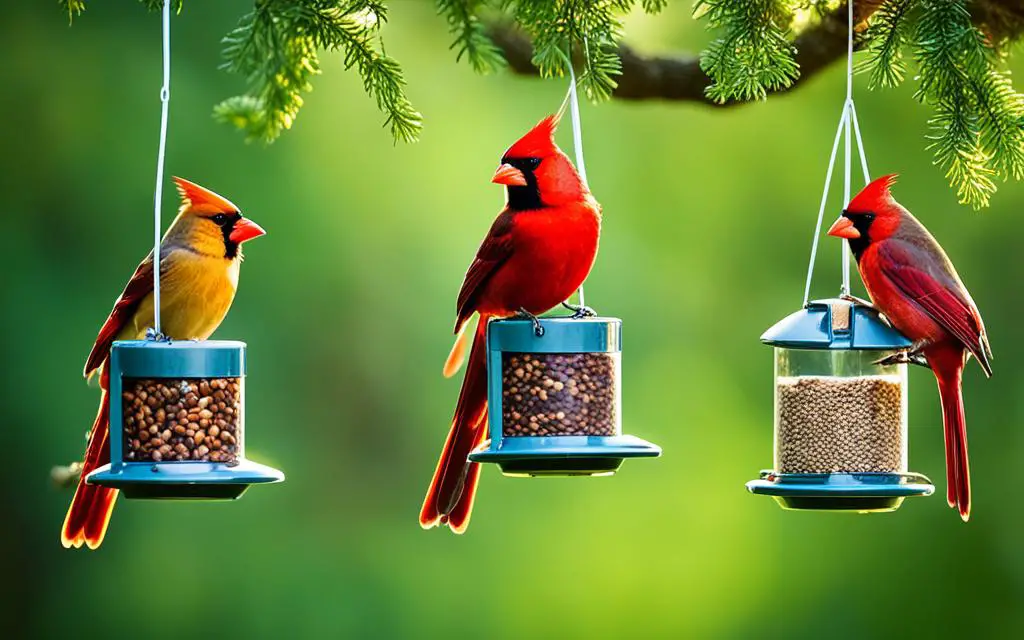
Choosing the Perfect Cardinal Bird Feeder
When it comes to attracting cardinals to your yard, choosing the right bird feeder is crucial. Cardinals prefer sturdy feeders that can support their weight and provide easy access to food. Platform feeders and feeders with built-in trays are ideal for cardinals, as they offer a comfortable feeding experience.
Placement is also key in attracting cardinals to your feeder. Placing the feeder near trees and shrubs provides cardinals with the cover they prefer while feeding. This allows them to feel safe and secure, increasing the likelihood of frequent visits.
In addition to cardinal comfort, it’s important to consider squirrel-proof and predator-safe options. Squirrels are notorious for raiding bird feeders, so choosing a squirrel-proof bird feeder can help ensure that the food is reserved for the cardinals. Look for feeders with mechanisms that deter squirrels, such as weighted perches or protective cages.
Predator-safe feeders are essential for the safety of cardinals. They help protect cardinals from potential threats, such as predators like cats or larger birds. Consider feeders with design features that restrict access to larger animals, such as baffles or cages that only allow smaller birds like cardinals to access the food.
By selecting the perfect cardinal bird feeder and placing it in the right location, you can create an inviting space for these beautiful birds to enjoy their meals while ensuring their safety.
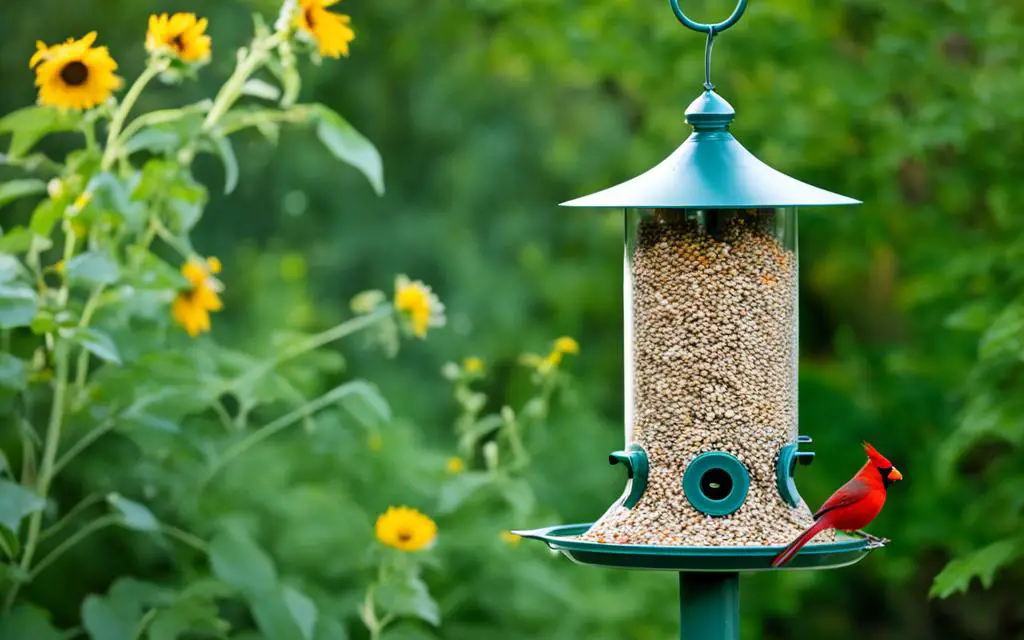
Feeding Cardinals: Best Seed Selections
When it comes to attracting cardinals to your yard, choosing the right seeds for your bird feeders is key. Cardinals have specific preferences when it comes to seed selection, and providing them with their favorite choices will help ensure their presence in your backyard.
So, what are the best seeds for cardinals? Here are three varieties that cardinals enjoy:
- Safflower Seeds: Cardinals absolutely love safflower seeds. These seeds have a thick shell that deters squirrels but is no match for the strong beak of a cardinal. Placing safflower seeds in your feeders will greatly attract these beautiful birds.
- Black Oil Sunflower Seeds: Another favorite among cardinals, black oil sunflower seeds are highly nutritious and provide cardinals with the energy they need. Their small size and thin shell make them easy for cardinals to crack open and enjoy.
- White Milo: While not as common as safflower or sunflower seeds, white milo is also a preferred seed choice for cardinals. Its unique size and shape appeal to cardinals and provide them with a diverse and interesting food option.
By including these seeds in your bird feeder, you’ll create an enticing spread that will attract cardinals to your yard. Remember to keep your feeders well-stocked and clean to ensure a steady supply of delicious seeds for your feathered visitors.
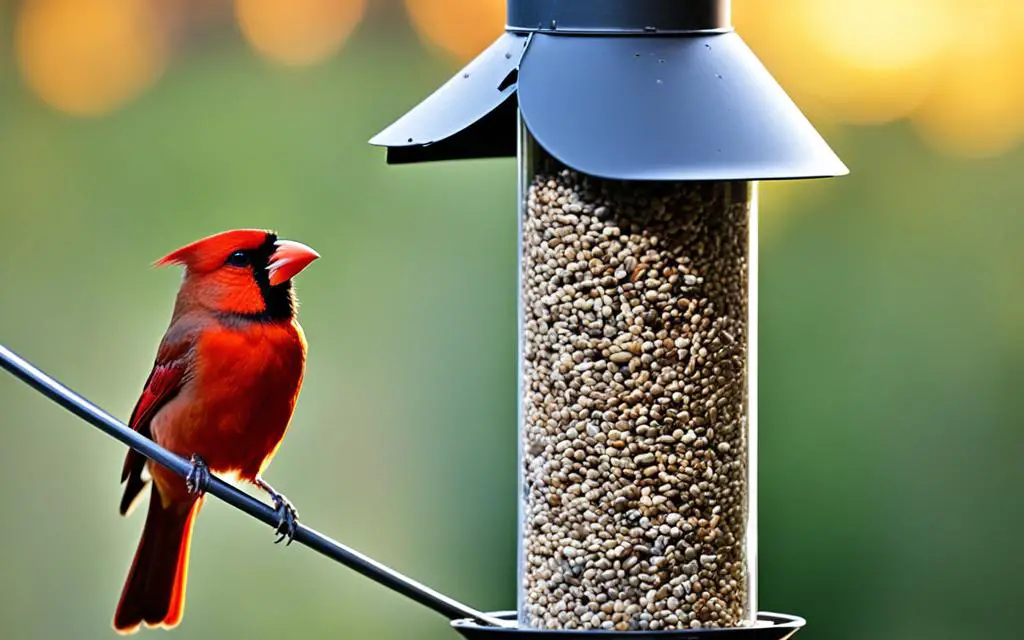
Comparison of Cardinal Food Preferences
| Seed Type | Description | Cardinal Preference |
|---|---|---|
| Safflower Seeds | Thick-shelled seeds, deters squirrels | Highly Preferred |
| Black Oil Sunflower Seeds | Nutritious, small size, thin shell | Highly Preferred |
| White Milo | Diverse and interesting seed | Preferred |
Table: A comparison of cardinal food preferences, highlighting the seeds they prefer the most.
Attractive Trees and Shrubs for Cardinal Shelter
Cardinals seek areas with dense vegetation that provide shelter and nesting opportunities. Planting suitable trees and shrubs in your yard can create an inviting habitat for these beautiful birds. Native plants and evergreen trees are particularly attractive to cardinals due to their year-round foliage and familiar surroundings.
Evergreen and Native Plants for Year-Round Protection
Consider planting evergreen trees such as Eastern Red Cedar, White Pine, or American Holly. These trees provide consistent cover and protection for cardinals throughout the year. In addition, native plants like Eastern Redbud, Purple Coneflower, and Virginia Creeper can enhance their habitat by offering natural food sources while providing shelter.
By selecting plants that are native to your region, you can create an eco-friendly environment that supports the local ecosystem and encourages the presence of cardinals. Native plants are adapted to the local climate, require less maintenance, and attract a variety of insects and other wildlife that cardinals rely on for food.
Creating a diverse landscape with a range of plant species and heights can offer cardinals nesting options and perching spots. Incorporating tall trees, medium-sized shrubs, and ground covers can provide a layered habitat that meets the various needs of cardinals throughout their lifecycle.
Varied Plant Heights for Nesting and Perching
Cardinals prefer to nest in shrubs or thickets, especially those with dense foliage that offers protection from predators. Shrubs like American Beautyberry, Red Osier Dogwood, and Multiflora Rose can provide excellent nesting sites for cardinals. Their dense growth and thorny branches create a safe environment for cardinal pairs to build their nests.
Additionally, incorporating tall trees like Oak, Maple, or Sweetgum can offer cardinals elevated perching spots from which they can survey their surroundings. These trees provide cardinals with advantageous vantage points to spot potential threats or other birds, contributing to their overall safety and well-being.
By choosing appropriate trees and shrubs for cardinal shelter, you can transform your yard into a haven for these magnificent birds. Their presence will not only bring beauty and joy to your surroundings but also contribute to the overall health of your local ecosystem.
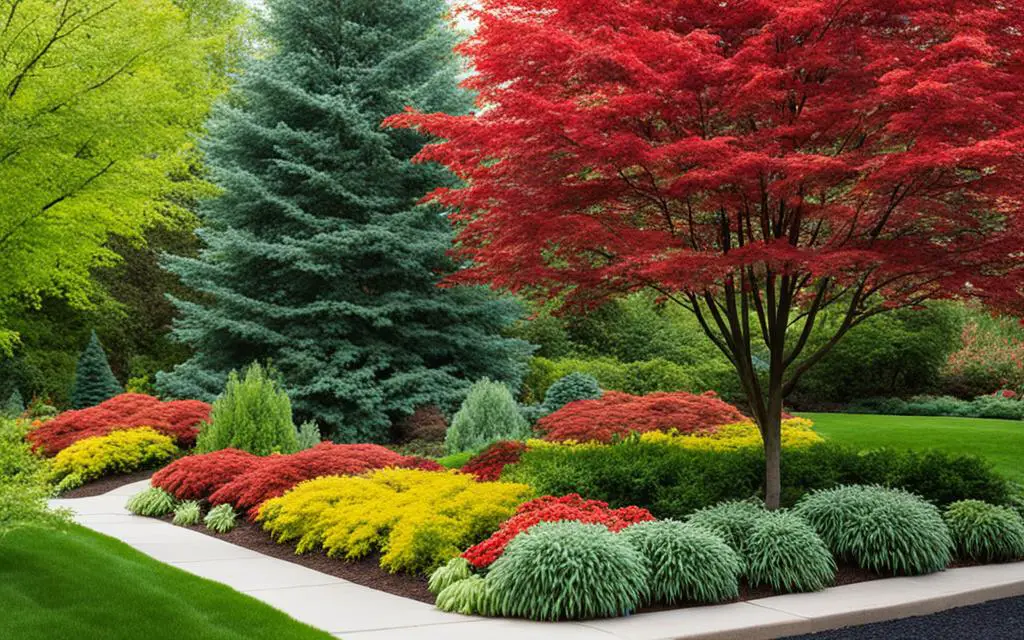
Creating a Cardinal-Friendly Water Source
Cardinals need access to fresh water for drinking and bathing. Providing a cardinal-friendly water source in your yard will attract these beautiful birds and enhance their overall habitat. One of the best options for providing water to cardinals is by setting up a birdbath.
Birdbath Designs That Cardinals Prefer
When choosing a birdbath for cardinals, consider a design that meets their preferences. Cardinals prefer birdbaths with a depth of 2 to 3 inches, as it allows them to drink and bathe comfortably. The edges of the birdbath should also be gently sloping to provide easy access for the birds.
Maintaining Water Sources Through Winter
During the winter months, it’s important to provide cardinals with a winter water source. Although birds can consume snow for hydration, having access to liquid water is crucial for their survival. To maintain a winter water source, consider adding a heater or de-icer to the birdbath to prevent the water from freezing.
Remember to regularly clean the birdbath to ensure that the water remains clean and fresh. This will entice cardinals to visit your yard regularly and enjoy the refreshing water you provide.
Nesting Site Essentials for Attracting Cardinals
Offering Safe and Suitable Nesting Materials
Cardinals, with their beautiful plumage and melodious songs, are a delight to have in any backyard. To attract these vibrant birds and create a welcoming habitat, it’s important to provide them with suitable nesting sites. Cardinals prefer natural nesting sites such as tall trees, shrub thickets, and grapevines. These locations offer the necessary protection and cover they need for breeding and raising their young.
To encourage cardinals to nest in your yard, it’s essential to offer them safe and suitable nesting materials. Pine needles, small twigs, and grass clippings are ideal options. Cardinals use these materials to construct their nests, which are usually cup-shaped and built in the fork of a branch or in dense vegetation. By providing these nesting materials, you can create an inviting environment that meets their nesting requirements.
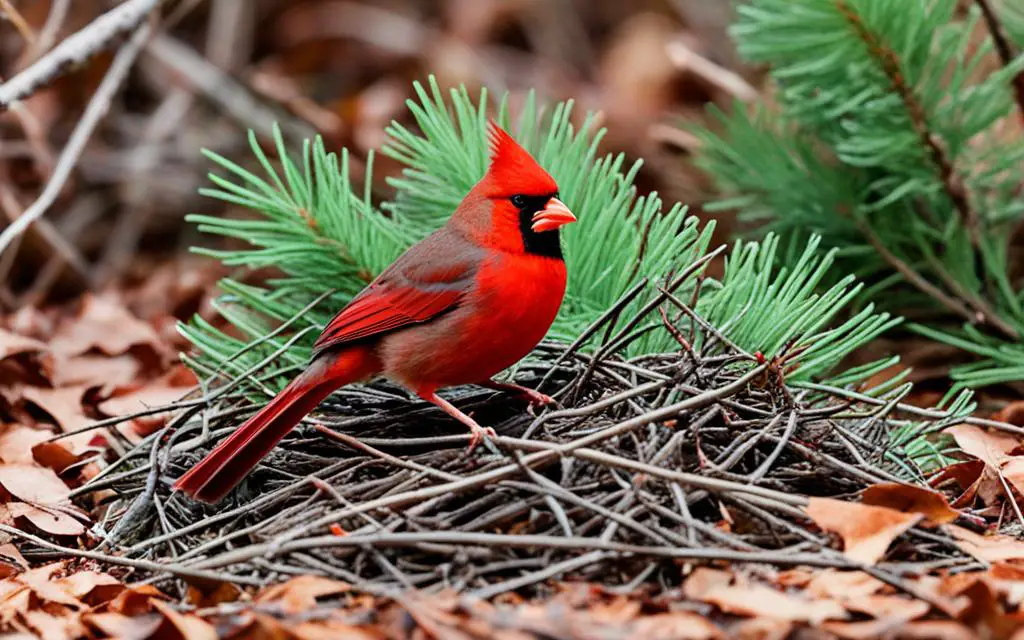
Avoiding Birdhouses: Understanding Cardinal Nesting Behaviors
While many bird species readily accept birdhouses as nesting sites, cardinals have a distinct preference for natural nesting locations. They typically avoid traditional birdhouses and instead opt for foliage-based nests. Understanding this behavior is crucial to creating a suitable environment for cardinals.
Cardinals prefer to build their nests in concealed, covered areas that provide protection from predators. They often select dense shrubs or the mid-level branches of tall trees. By focusing on creating dense, natural vegetation in your yard, you can offer the cardinal nesting sites they prefer.
Designing Your Yard with Cardinals in Mind: A Guide to Plant Choices
When it comes to attracting and sustaining cardinals in your yard, the right plant choices can make all the difference. By selecting plant varieties that are attractive to cardinals, you can create an environment that not only appeals to these beautiful birds but also supports their needs for food and shelter. Native plants, in particular, play a crucial role in creating an eco-friendly bird habitat.
Plant Varieties That Attract and Sustain Cardinals
Cardinals are attracted to plants that produce fruits, berries, and seeds. Including these varieties in your yard can provide a natural food source that cardinals will find irresistible. Consider planting fruit trees such as cherry, plum, or crabapple. These trees not only offer delicious fruits but also attract cardinals with their vibrant colors and foliage.
In addition to fruit trees, including shrubs such as dogwood, viburnum, and elderberry can provide cardinals with an abundance of berries. These berries offer a nutritious food source that cardinals will frequent throughout the year. Sunflowers are also a favorite among cardinals, as their large seed heads provide a substantial meal.
By incorporating a diverse range of plant varieties that produce fruits, berries, and seeds, you can ensure a continuous food supply that will attract and sustain cardinals in your yard.
Using Native Plants to Create an Eco-Friendly Bird Habitat
Native plants are not only beautiful but also play a vital role in creating an eco-friendly bird habitat. Native plants are well-adapted to the local environment and provide essential resources for birds, including cardinals.
By using native plants in your yard, you can provide cardinals with familiar and reliable food sources. Native plants have co-evolved with local wildlife, including birds, and offer a variety of berries, seeds, and nectar that support their dietary needs.
In addition to food sources, native plants also provide critical shelter and nesting sites for cardinals. Their dense foliage and structure offer protection from predators and create a sense of security for cardinals that choose to call your yard home.
Furthermore, native plants contribute to the overall health of the ecosystem by supporting pollinators and other wildlife. They require less water, fertilizer, and pesticides, making them a sustainable choice for your yard.
Overall, designing your yard with cardinals in mind involves selecting plant varieties that attract and sustain these beautiful birds. By incorporating plants that produce fruits, berries, and seeds, and using native plants to create an eco-friendly habitat, you can create a welcoming sanctuary that cardinals will flock to.
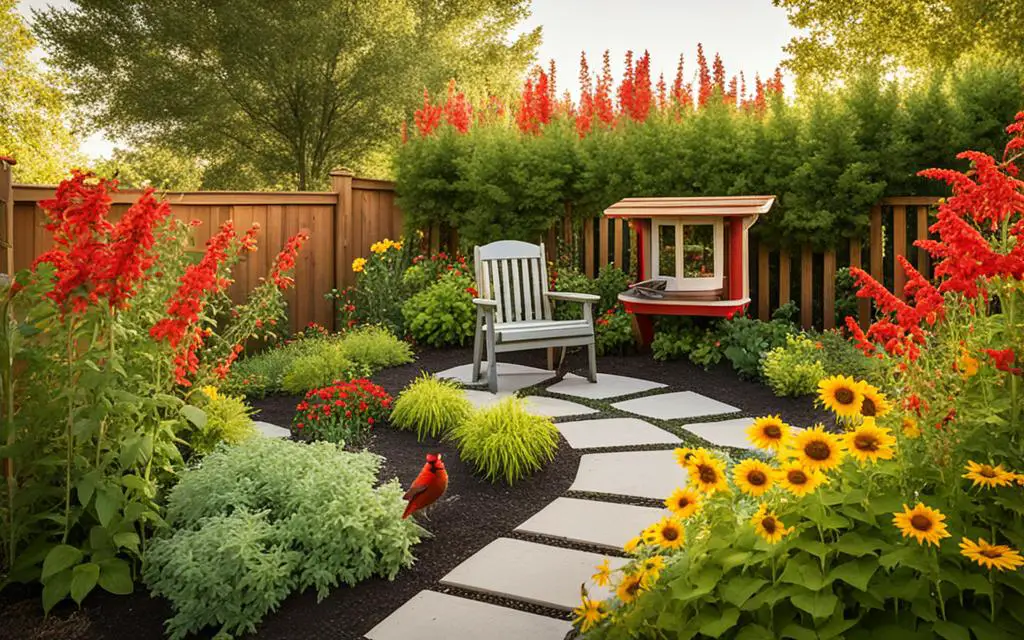
Garden Modifications to Deter Cardinal Predators
Making some simple garden modifications can help deter predators and ensure the safety of cardinals in your yard. By implementing these measures, you can create a secure environment that promotes the well-being of these beautiful birds.
Pet Management Near Cardinal Feeding Areas
If you have pets, it’s important to manage their presence near cardinal feeding areas. Dogs and cats can pose a threat to cardinals and other backyard birds. To prevent any unwanted interactions, consider implementing the following pet management strategies:
- Supervise your pets while they are outside, especially during peak feeding times.
- Keep your pets indoors or in a confined area during cardinal feeding hours.
- Create a separate feeding area for your pets away from the cardinal bird feeders.
- Train your pets not to chase or disturb the birds.
By ensuring responsible pet management, you can minimize the risk of your pets disturbing cardinals and other avian visitors to your yard.
Strategic Feeder Placement to Reduce Predator Attacks
The placement of your bird feeders can play a crucial role in deterring predator attacks on cardinals. Consider the following tips when positioning your feeders:
- Place feeders at least 10-12 feet away from any shrubs or trees where predators might hide.
- Position feeders near open spaces, such as lawns or clearings, where it is more difficult for predators to approach undetected.
- Ensure there is a clear line of sight from nearby windows or other vantage points in your home to monitor potential threats.
- Consider using squirrel-proof feeders that are designed to prevent access by large predators.
By strategically placing your feeders and reducing potential hiding spots for predators, you can create a safer feeding environment for cardinals, allowing them to visit your yard with confidence.
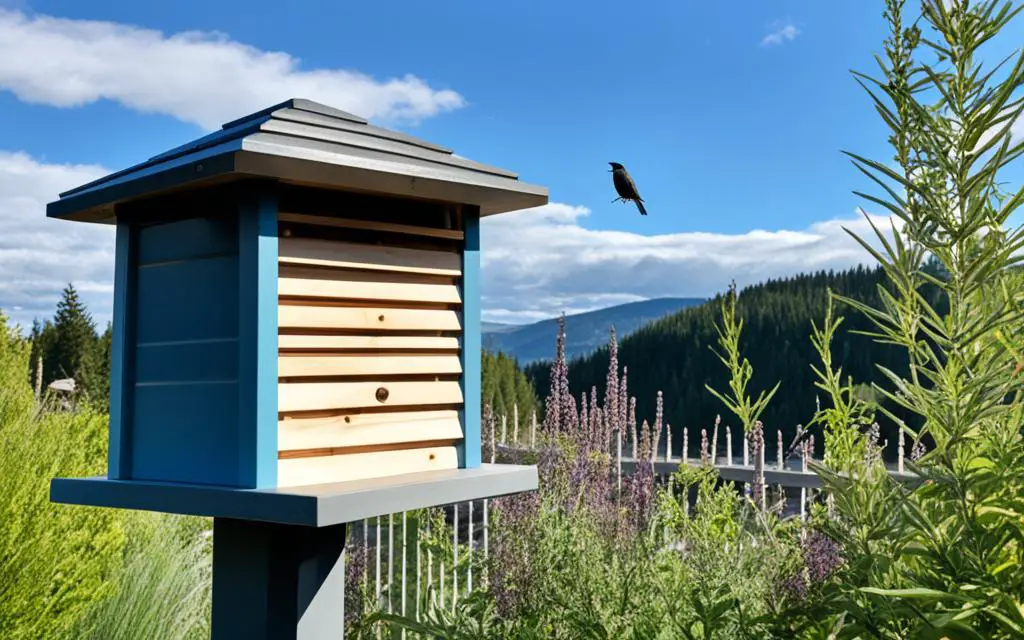
Seasonal Considerations for Cardinal Visitors
Cardinals stay in their habitat year-round, so it’s important to consider their needs during different seasons. By making appropriate adjustments, you can ensure the well-being of cardinals in your yard throughout the year.
Adjusting Bird Feeding Practices for Winter Weather
During the winter, cardinals face challenges in finding food sources due to colder temperatures and limited availability of natural food. Adapting your bird feeding practices to accommodate their needs can help them thrive during this season.
One essential aspect is providing adequate food options that are suitable for winter feeding. Cardinals particularly enjoy consuming seeds, such as safflower seeds, black oil sunflower seeds, and white milo. These seeds provide essential nutrients and energy for cardinals to withstand the cold weather.
You can also consider offering suet, which is a high-fat food that provides extra energy to keep cardinals warm. Suet feeders can be placed in sheltered locations to protect them from snow and wind.
It’s crucial to ensure that the bird feeders are kept clean and filled regularly during the winter months. Regular cleaning helps prevent the growth of harmful bacteria and molds that can be detrimental to the birds’ health.
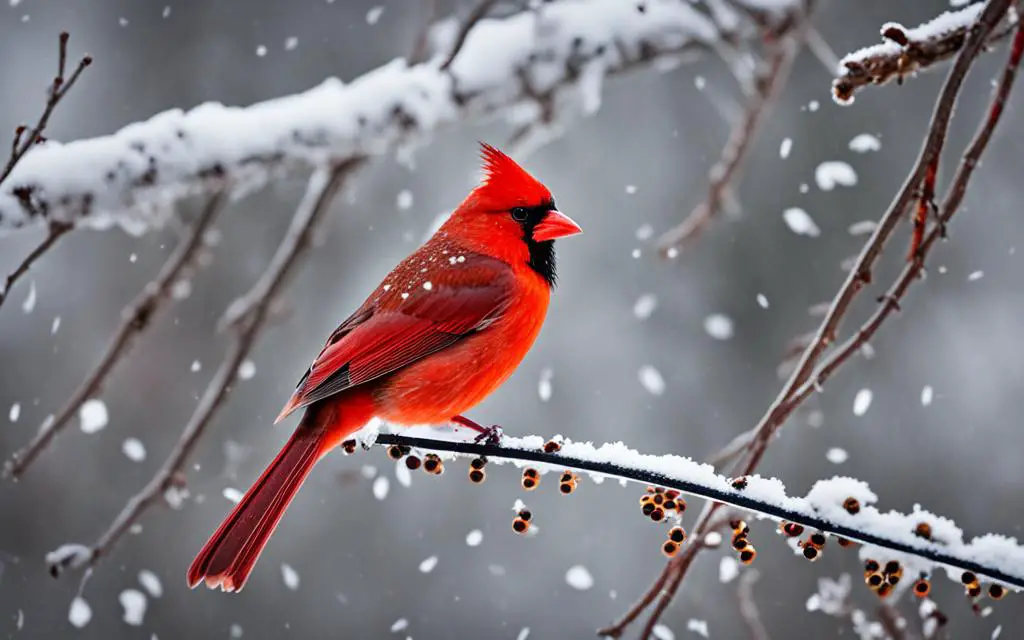
Protective Measures During Cardinal Breeding Season
Cardinal breeding season typically occurs from late March to early August. During this period, it’s essential to take protective measures to provide a safe environment for cardinals as they nest and raise their young.
One crucial step is to avoid trimming or pruning trees and shrubs during the breeding season, as this may disturb or destroy cardinal nests. By refraining from these activities, you allow cardinals to nest undisturbed and successfully raise their offspring.
Another protective measure is to limit disturbances near the nesting areas. Loud noises, sudden movements, and the presence of pets can cause stress and potentially lead to nest abandonment. Keeping a respectful distance and creating a quiet environment will help minimize disruptions.
Additionally, it’s essential to prevent potential predators from accessing nesting sites. Placing bird feeders and birdhouses away from shrubs or trees that predators can climb will decrease the likelihood of nest predation.
By adjusting your bird feeding practices during winter and taking protective measures during the breeding season, you can actively contribute to the well-being and conservation of cardinals in your yard.
Frequently Asked Questions about Attracting Cardinals
Do you have questions about attracting cardinals to your yard? Here are answers to some frequently asked questions about cardinal bird facts and behavior:
Q: How can I attract cardinals to my yard?
A: Creating a suitable habitat that includes food sources, water, and shelter is key to attracting cardinals. Planting native trees and shrubs, providing bird feeders with their preferred seeds, and offering a birdbath are effective ways to attract these beautiful birds.
Q: What are some cardinal bird facts?
A: Cardinals, also known as Northern Cardinals, are known for their bright red plumage and distinctive crests. They are non-migratory birds that can be found in various regions of North America. Cardinals are known for their beautiful songs and mate for life.
Q: What is cardinal behavior like?
A: Cardinals are social birds that are often seen in pairs. They are territorial and will defend their territory vigorously. Male cardinals are known for their territorial songs to proclaim their presence. They are also known for their ability to crack open seeds with their strong beaks.
Q: What types of feeds do cardinals prefer?
A: Cardinals enjoy a variety of foods, including safflower seeds, black oil sunflower seeds, crushed peanuts, cracked corn, berries, and suet. Providing a mix of these foods in your bird feeders will help attract cardinals to your yard.
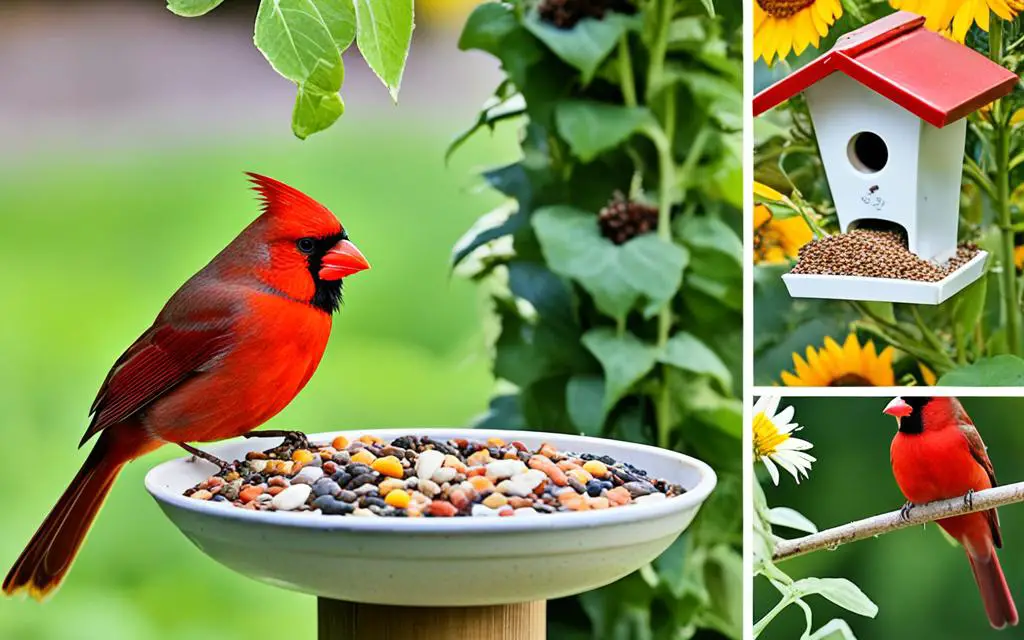
| Question | Answer |
|---|---|
| How can I attract cardinals to my yard? | Creating a suitable habitat that includes food sources, water, and shelter is key to attracting cardinals. |
| What are some cardinal bird facts? | Cardinals are known for their bright red plumage and distinctive crests, and they are non-migratory birds. |
| What is cardinal behavior like? | Cardinals are social birds that are often seen in pairs and are known for their territorial songs. |
| What types of feeds do cardinals prefer? | Cardinals enjoy safflower seeds, black oil sunflower seeds, crushed peanuts, cracked corn, berries, and suet. |
Conclusion
Attracting cardinals to your yard is an exciting endeavor that requires careful consideration and implementation of various strategies. By providing a suitable habitat, offering the right food sources, and ensuring access to fresh water, you can create an inviting environment for cardinals to thrive.
Throughout this article, we have discussed the importance of understanding cardinal preferences, choosing the right feeders and seeds, creating suitable nesting sites, and designing your yard with native plants. These cardinal yard enhancements are key to attracting and enjoying these beautiful birds.
By incorporating our cardinal birding tips into your backyard birdwatching routine, you can increase your chances of attracting cardinals and observing their vibrant plumage and enchanting songs. Remember to place your feeders strategically, providing cover and protection from predators, while also considering seasonal adjustments to meet their specific needs.
Implementing these cardinal yard enhancements not only benefits cardinals but also contributes to the overall biodiversity of your yard. Native plants, nesting materials, and a clean water source provide a sustainable habitat for various bird species, promoting a healthy ecosystem.
So, why wait? Start implementing these cardinal birding tips and enjoy the vibrant presence and enchanting melodies of cardinals in your own backyard. Embark on a rewarding birdwatching journey and create a haven that cardinals and other feathered friends will love to visit.
References
For further information on attracting cardinals to your yard and creating a cardinal-friendly habitat, consider exploring the following sources:
- All About Birds – Northern Cardinal: This comprehensive guide provides detailed information on the behavior, habitat, and feeding preferences of Northern Cardinals.
- Audubon – Birding Basics: Cardinals: Audubon offers valuable insights into attracting and observing cardinals, including tips on feeders, bird baths, and nesting sites.
- Wildlife Gardeners Forum – Ideas for Attracting Cardinals to Your Yard: This discussion thread provides practical suggestions and personal experiences shared by bird enthusiasts.
- Birds of North America – Northern Cardinal: An in-depth scientific resource that covers the distribution, habitat, behavior, and conservation of the Northern Cardinal.
By referring to these reputable sources, you can gain further knowledge to enhance your cardinal birdwatching experience and create a welcoming environment for these beautiful birds in your own backyard.
FAQ
What are some tips for attracting cardinals to my yard?
To attract cardinals to your yard, provide a habitat with dense vegetation, such as evergreen trees and shrubs. Offer a variety of hearty foods like safflower seeds, black oil sunflower seeds, and berries. Use bird feeders that are sturdy and placed near trees and shrubs for cover. Provide a water source like a birdbath and nesting materials like pine needles and grass clippings. By creating a welcoming environment, you can attract cardinals to your yard.
How can I choose the right bird feeder for attracting cardinals?
Cardinals prefer platform feeders and feeders with built-in trays that can hold their desired foods. Look for feeders that are sturdy and can support the weight of cardinals. Additionally, consider using squirrel-proof feeders to protect the food and ensure it is available for the cardinals.
What are the best seeds to attract cardinals?
Cardinals enjoy safflower seeds, black oil sunflower seeds, and white milo. These seeds can be included in your bird feeder to attract cardinals to your yard.
What types of trees and shrubs are attractive to cardinals?
Cardinals prefer areas with dense vegetation for shelter and nesting. Planting evergreen trees, native plants, and a variety of shrubs of different heights provides them with the shelter they need year-round. Look for trees and shrubs that produce fruits, berries, and seeds that cardinals enjoy.
How can I deter predators from attacking cardinals in my yard?
Creating garden modifications such as brush piles and managing pets near cardinal feeding areas can help deter predators. Additionally, placing feeders strategically and away from potential hiding spots for predators can reduce the risk of attacks.
Do cardinals migrate?
No, cardinals are non-migratory birds. Once they find a suitable habitat, they are likely to stay year-round.
What should I do to provide a suitable nesting site for cardinals?
Cardinals prefer natural nesting sites such as tall trees, shrub thickets, and grapevines. Providing them with nesting materials such as pine needles, small twigs, and grass clippings will encourage them to stay and nest in your yard.
What are some suitable plants for attracting cardinals?
Certain plants produce fruits, berries, and seeds that cardinals enjoy. Using native plants in your yard not only attracts cardinals but also creates a sustainable and eco-friendly bird habitat. Some attractive plant choices for cardinals include dogwood, serviceberry, elderberry, and butterfly bush.
How can I adjust my bird feeding practices for winter weather?
During winter, it is essential to provide additional food sources for cardinals, as natural food may become scarce. Offering high-fat foods like suet can help sustain cardinals during the colder months. It is also crucial to keep water sources available and free of ice, as cardinals need access to fresh water year-round.
Where can I find more information about attracting cardinals to my yard?
For more information about attracting cardinals to your yard, consult reputable birding guides, websites, and resources dedicated to wildlife gardening and birdwatching. They provide valuable tips and insights specific to your region. Additionally, connecting with local birding clubs and experienced birdwatchers can offer practical advice and recommendations.
Source Links
- https://www.perkypet.com/articles/how-to-attract-cardinals
- https://www.marthastewart.com/8117757/how-attract-cardinals-backyard
- https://www.birdforum.net/threads/attract-cardinals-in-my-backyard.417682/

My name is Shane Warren, the author behind Your Bird Buddy – your ultimate guide to the wonderful world of birds! Unleash your inner avian explorer as we delve into a vibrant library of knowledge dedicated to all things feathered. From learning about diverse bird species from across the globe to understanding their captivating habitats and behaviors, I’m here to fuel your passion for these magnificent creatures. Not only that, but I also provide valuable insights on being a responsible and informed pet bird owner. Join our vibrant community and let’s celebrate the feathered wonders of the world together – one chirp at a time. And be sure to join our Your Bird Buddy Community over on Facebook!

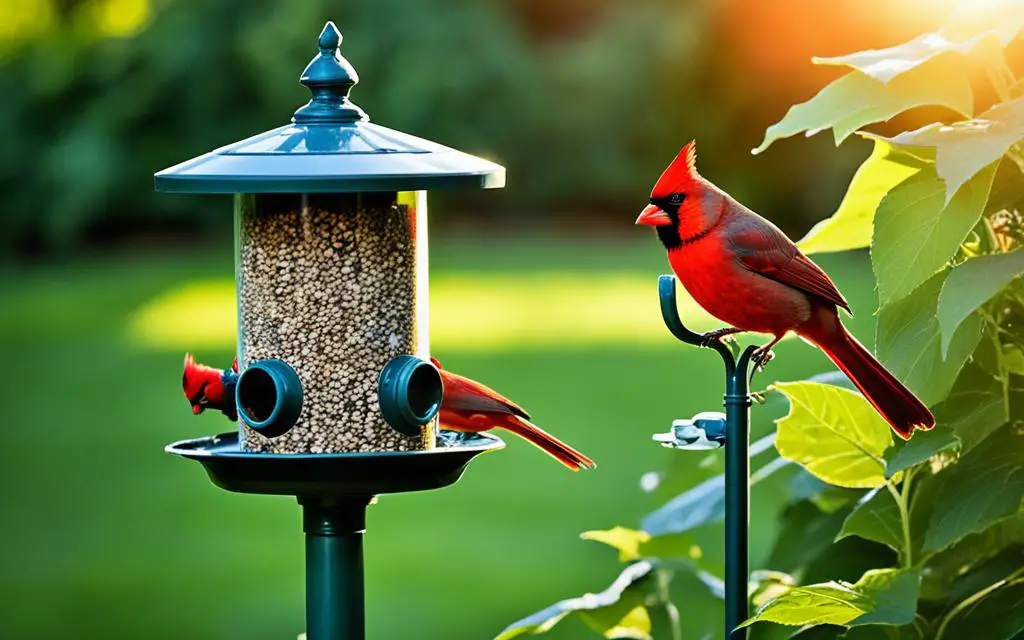
Comments are closed